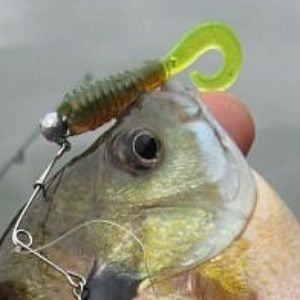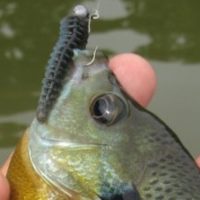I recently started searching for panfish in my kayak and haven’t had a lot of luck getting on them so I’m constantly retreating to a captive panfish audience in the family pond. What’s your tips on finding gills and crappies this time of year? Once you find them what’s your favorite catching method? On the pond it’s hard to beat a white Road Runner tipped with a Kalin’s T.T. Crappie Scrub.
IDO » Forums » Fishing Forums » Fishing by Species » Bluegills, Crappies, Perch & Whitebass » Locating spring panfish and tactics
Locating spring panfish and tactics
-
 bigpike
Posts: 6259May 5, 2017 at 1:11 pm #1692565
bigpike
Posts: 6259May 5, 2017 at 1:11 pm #1692565In the Phillips area the gils and crappy are just moving into the shallows, warming calm days are best. Cold fronts push them back out. Find the warmest water in the lake, then fish close to and around brush, stumps any vegetation. I stick with garden worms and crappy minnows under a float on a medium ice jig.
 Spoon Minnow
Posts: 367July 25, 2017 at 2:53 pm #1706595
Spoon Minnow
Posts: 367July 25, 2017 at 2:53 pm #1706595Any time of year, the only way to find fish (any species that bite lures) is to cast lures any places that fish may accumulate, whether in schools, small groups of five or less or dispersed in the same area. The only way I’ve been successful finding fish are the large number of casts to higher potential areas. I’ve only been skunked once this year in early spring, but most likely because I couldn’t explore more areas due to high wind and my small boat.
When it comes to search lure that always work when fish are found, the ball head jig and a soft plastic lure is hard to beat. Also important in my experience is a slow retrieve interrupted by pauses and rod tip twitches along with 1/4 reel handle turns. For any species of fish, there are well over 50 soft plastic design choices – many derived from lures you already own.
For example, 4″-5″ bass finesse worms are a surefire source of lures that quiver and excite fish to strike when fished very slow but steadily at one depth. I cut off the last 2″ of the tail of the worm and rig it on a 1/16 oz ball head jig. I’m not a big fan of curl tail grubs except of a particular design and don’t like the more constant speed required keep the tail moving to catch fish. That’s just my personal bias even though before I used no-action-tail lures I did catch many fish on curl tails.
Fish may hold at many depths in one day and finding those depths using the above search lure, insures contact sooner or later and may lead to a pattern of the depths fish are holding at and areas related to shoreline or mid-lake humps and other structure.
If pre-spawn fish are hard to come by, soon enough large schools will be shallow and near emerging weeds. It’s the most action I’ve ever gotten at that time of year and numbers of fish caught astound!
Again, the above works any time of year especially in shallow lakes 20′ deep or less with large flats of 5′ or less depth. Sonar is essential before and after fish are caught in order to know where fish are holding. Once found, many lures work as long as they can be worked slowly.
The example below is 2″ of the tail end of a Ring Worm cut off and rigged on a 1/16 oz unpainted ball head jig:
You must be logged in to reply to this topic.
